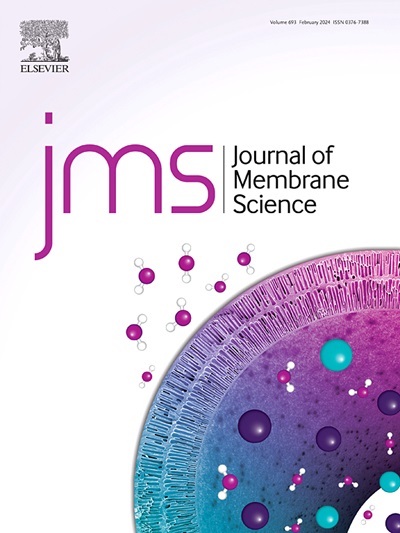设计环己酮/环己醇高效分离的铝基MOF膜孔径和孔电负性环境
IF 8.4
1区 工程技术
Q1 ENGINEERING, CHEMICAL
引用次数: 0
摘要
金属-有机框架膜(MOF)由于其相对于传统蒸馏工艺低碳足迹的优点,在渗透蒸发分离方面显示出巨大的前景。膜在环己酮/环己醇渗透蒸发分离过程中的选择性差是限制MOF膜应用的关键因素之一。本文合理设计了MOF膜的孔径和孔环境中的电负性,用于区分环己酮和环己醇分子。与CAU-23和KMF-1等铝基MOF膜相比,MIL-160膜具有更短的配体长度,可以获得更小的孔径,用于高效的环己酮/环己醇分子筛选。同时,相对于环己醇,MIL-160膜中配体呋喃环上的高电负性O与环己酮分子的相互作用更强,导致环己酮和环己醇的吸附差异较大。MIL-160膜的总通量为120 g m−2 h−1,环己酮/环己醇的分离系数最高,分别是CAU-23和KMF-1膜的36倍、10.2倍和3.8倍,是ZIF-78和Cu2O@g -C3N4-PVDF膜的72倍和2倍。该研究表明,在孔环境中同时设计孔径和电负性是提高MOF膜渗透汽化性能的一种很有前途的方法。本文章由计算机程序翻译,如有差异,请以英文原文为准。

Designing pore size and pore electronegativity environment in aluminum-based MOF membranes for efficient cyclohexanone/cyclohexanol separation
Metal-organic framework (MOF) membranes have shown great promise for pervaporation separation due to the merit of the low carbon footprint relative to the traditional distillation process. The poor selectivity of the membrane in the cyclohexanone/cyclohexanol pervaporation separation process is one of the key factors limiting the application of the MOF membrane. Herein, pore size and electronegativity in the pore environment of MOF membranes were rationally designed for discriminating cyclohexanone and cyclohexanol molecules. Compared to the aluminum-based MOF Membranes including the CAU-23 and KMF-1 membranes, the MIL-160 membrane had a shorter-length ligand to get a smaller pore size for efficient cyclohexanone/cyclohexanol molecular sieving. Meanwhile, the stronger interaction between a highly electronegative O in the furan ring of the ligand in the MIL-160 membrane and the cyclohexanone molecule relative to the cyclohexanol led to the high adsorption difference of cyclohexanone and cyclohexanol. The MIL-160 membrane exhibited a total flux of 120 g m−2 h−1 and the highest cyclohexanone/cyclohexanol separation factor of 36, 10.2-fold and 3.8-fold separation factor compared with the CAU-23 and KMF-1 membranes and 72-fold and 2-fold separation factor compared with the reported ZIF-78 and Cu2O@g–C3N4–PVDF membranes, respectively. This research demonstrates that simultaneously designing pore size and electronegativity in the pore environment is a promising way to enhance the pervaporation performance of MOF membranes.
求助全文
通过发布文献求助,成功后即可免费获取论文全文。
去求助
来源期刊

Journal of Membrane Science
工程技术-高分子科学
CiteScore
17.10
自引率
17.90%
发文量
1031
审稿时长
2.5 months
期刊介绍:
The Journal of Membrane Science is a publication that focuses on membrane systems and is aimed at academic and industrial chemists, chemical engineers, materials scientists, and membranologists. It publishes original research and reviews on various aspects of membrane transport, membrane formation/structure, fouling, module/process design, and processes/applications. The journal primarily focuses on the structure, function, and performance of non-biological membranes but also includes papers that relate to biological membranes. The Journal of Membrane Science publishes Full Text Papers, State-of-the-Art Reviews, Letters to the Editor, and Perspectives.
 求助内容:
求助内容: 应助结果提醒方式:
应助结果提醒方式:


